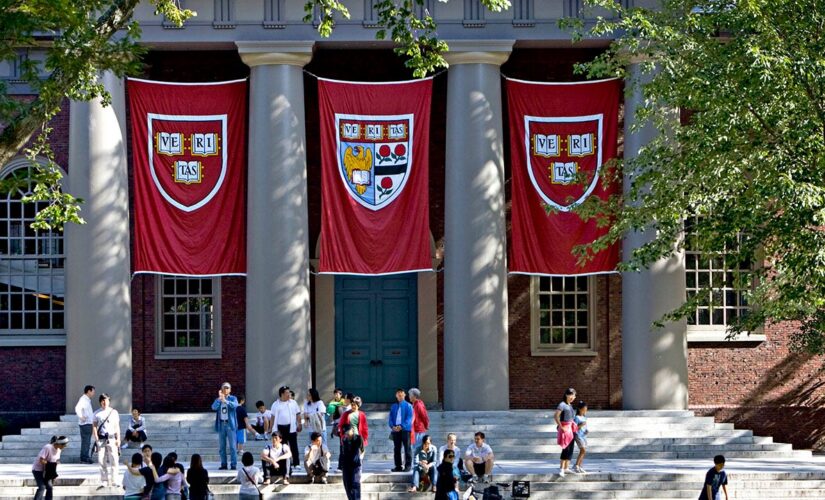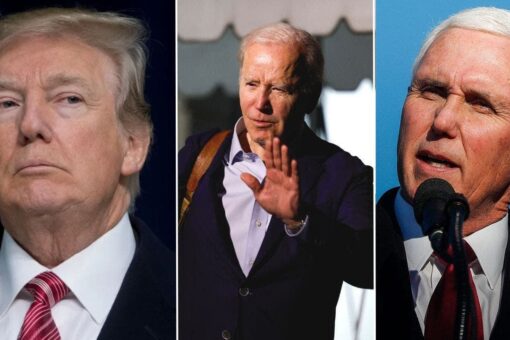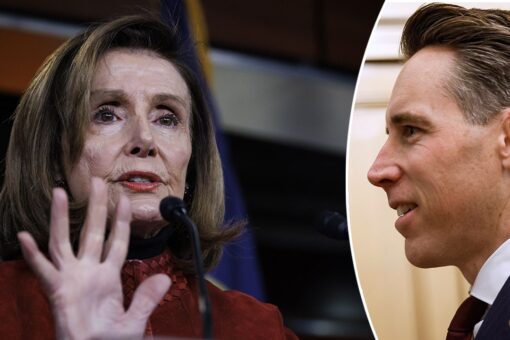In 2003, Justice Sandra Day O’Connor was the “swing”– or deciding– vote in a landmark Supreme Court case over race– perhaps the most divisive social, political, and cultural issue in the country’s history.
While upholding the University of Michigan’s affirmative action policies for minority law school applicants, the court majority led by O’Connor offered this caveat: “We expect that 25 years from now, the use of racial preferences will no longer be necessary to further the interest approved today.”
Fast-forward 19 years, and a seemingly impatient 6-3 conservative court majority is poised to severely limit when colleges and universities can use race as part of the competitive admissions process.
The justices will hear two separate legal challenges back-to-back on Monday over just how Harvard University— a private institution– and the University of North Carolina– a public one– decide who fills their classrooms.
UNITED STATES – SEPTEMBER 03: Harvard banners hang outside Memorial Church on the Harvard University campus in Cambridge, Massachusetts, U.S., on Friday, Sept. 4, 2009.
(Photo by Michael Fein/Bloomberg via Getty Images)
These prominent schools say their standards have a larger societal goal, one endorsed for decades by the courts: to promote a robust, intellectually diverse campus for future leaders.
A coalition of Asian American students, however, says the criteria discriminates with a “racial penalty”– holding them to a selectively higher standard than many Black and Hispanic students.
“They are intent on cultivating this brand of prestige by any means,” said Kenny Xu, president of the group Color Us United, and author of “An Inconvenient Minority.” “The idea of the Civil Rights Act of 1964 was that the state should not discriminate on the basis of race. It doesn’t matter if you’re doing it one way or another.”
It is the most closely-watched case of the Supreme Court term so far, coming just months after the nearly five-decade Roe v. Wade decision guaranteeing a constitutional, nationwide right to abortion was overturned.
“And there is yet again, as we saw on the abortion case last term, a request for the Supreme Court to ignore precedent,” said Elizabeth Wydra, president of the progressive Constitutional Accountability Center. “And to have a rather dramatic legal change that will affect the lives of young people and all of society with the overturning of using race-conscious measures in higher education.”
MAJORITY OF AMERICANS SUPPORT BANNING THE CONSIDERATION OF RACE DURING COLLEGE ADMISSIONS: POLL
What the justices decide after the oral arguments could not only affect college admissions, but other educational and professional employment opportunities for underrepresented groups.
Consideration of race in public university admissions is already banned in nine states, including California, Michigan, and Florida. Other public institutions in some states also ban the practice.
Reflecting the complexities of the issue, a new poll by The Washington Post and George Mason University released in October finds 63% of those surveyed support banning the consideration of race during college admissions. But the poll also found an almost equal number back programs to boost racial diversity on university campuses.
AFFIRMATIVE HISTORY
The idea of promoting a diverse workforce dates back to the 19th century, according to labor historians, but the concept was not codified until the Depression-era “New Deal” policies promoted by President Franklin Roosevelt.
On June 30, 2022, Justice Jackson took the oaths of office to become the 104th Associate Justice of the Supreme Court of the United States.
(Collection of the Supreme Court of the United States via Getty Images)
The National Labor Relations Act of 1935, guaranteeing collective bargaining, required employers engaging in discriminatory workplace practices to “take such affirmative action including reinstatement of employees with or without backpay.” It is believed to be the first time that phrase was used.
The concept was later applied under executive order during World War II to military defense firms with lucrative federal contracts, many of whom had refused to hire Black people and other minority workers.
A TIMELINE OF SUPREME COURT CASES ON AFFIRMATIVE ACTION IN COLLEGE ADMISSIONS
Finally, in 1961 came President John Kennedy’s Executive Order 10925, requiring government contractors to “take affirmative action to ensure that applicants are employed and that employees are treated during employment without regard to their race, creed, color, or national origin.” That was codified in the 1964 Civil Rights Act, and led to the creation of the Equal Employment Opportunity Commission. The protections were later applied to gender and sexual orientation.
The next legal frontier was in education, leading to the 1978 Supreme Court ruling in Regents of the University of California v. Bakke. Alan Bakke, a white man, was twice rejected for admission to medical school, claiming discrimination when his admission test scores were consistently higher than minority applicants.
The school had reserved 16 places in each entering class of one hundred for “qualified” minorities, which critics called a quota system. In a split opinion (six separate rulings by the nine justices), the high court upheld the use of affirmative action, allowing race to be one of several criteria in college admissions, with classroom diversity a permissible “compelling state interest.” But the majority also rejected specific racial quotas or set-asides.
As the court continued to articulate that precedent over the decades, its continued nuanced approach drew a predictable public divide.
It led to Justice O’Connor’s famous prediction in 2003. In 2013 and then three years later, the court heard appeals from Abigail Fisher, a white student rejected for undergraduate admission by the University of Texas. The 5-4 court upheld the school’s admissions policy, but tightened the legal standards schools must satisfy when justifying racial criteria.
Supreme Court of the United States.
(AP Photo/Patrick Semansky)
Conservative political and legal activist Edward Blum had recruited Fisher to challenge UT’s policies in the courts, and she now works alongside him and Fisher’s father at Students for Fair Admissions (SFFA). That group was founded in 2014 and is now suing in the Harvard and UNC cases.
PERSONALITY-DRIVEN
Harvard says it received more than 61,000 admission applications this school year, with a 3.2% acceptance rate. While much of the process remains secret, court records reveal university officials assigned numerical ratings in several categories to score applicants, including: academic, extracurricular, athletic, personal qualities, and overall accomplishments. The “personal” metric may be the most subjective, and has received the most scrutiny by the courts.
On the school’s website, admissions officers define “personal character” in part by asking: “What about your maturity, character, leadership, self-confidence, sense of humor, energy, concern for others, and grace under pressure?”
Documents filed by the school as part of the initial litigation stage in 2018 revealed other “soft” criteria applicants could be judged by: integrity, helpfulness, likability, kindness, and courage.
Some Asian American academic activists say they are unfairly labeled “test-taking robots with no personality,” who may have very high academic scores and extracurricular activities, but consistently rank low on Harvard’s “personality” equation, part of its overall “holistic” approach.
In a video released by SFFA, several of the original student plaintiffs speak about their experiences.
“Everyone’s looking for the same story, they don’t really care what you have to say. It’s always this: Asian kid, high test scores, mad you didn’t get in,” said Harrison Chen, a high school valedictorian. “I’m interested in how affirmative action is portrayed, because it’s so very dishonest.”
“I think the fact I’m Asian American plays a pretty big factor into why I was rejected,” said Calvin Yang, who had applied to the Ivy League school. “The admissions officer had– I don’t know for sure– but either a hard or soft quota on the number of incoming Asian American students into the Harvard Class of 2025.”
But Harvard and UNC strongly deny the allegations, and say their flexible policies strengthen the learning environment for all.
“Harvard College does not discriminate against applicants from any group in its admissions processes,” said the school on a specially-created website on their Supreme Court case. “We will continue to vigorously defend the right of Harvard, and other colleges and universities, to seek the educational benefits that come from a class that is diverse on multiple dimensions, from its capacity for academic excellence to its ability to help create a campus community that gives each student the opportunity to learn from peers with a wide variety of academic interests, perspectives, and talents.
The Massachusetts school’s Class of 2026 is about 15% Black, 13% Hispanic, and 28% Asian American. Officials told the high court Black and Hispanic representation would shrink by nearly half if they eliminated race-conscious measures.
One member of the court who will not hear the Harvard appeal is Justice Ketanji Brown Jackson. Until this spring, the prominent alumnus had been on the school’s governing Board of Overseers while the current case was being litigated. The court’s third Black justice chose to recuse from deciding the case.
Chief Justice John Roberts and Justices Elena Kagan and Neil Gorsuch are also Harvard Law School grads, but will hear the appeal.
Jackson will, however, help decide the separate University of North Carolina petition. A federal court had upheld the program at the state’s flagship public institution of higher learning.
TAKING SIDES
The two petitions have attracted dozens of amicus, or supporting, briefs from groups on both sides of the debate, an unusually large number.
Those backing the petitioners include states like Texas and Oklahoma, more than 80 Republican members of Congress, and former U.S. Attorney General Edwin Meese.
Organizations favoring the schools include the NAACP, 14 current Democratic U.S. senators, teachers’ unions, large corporations like Google and MasterCard, and former military leaders.
The schools’ most prominent backer may the country’s largest employer– the federal government. The Biden administration has filed amicus briefs in support of continued use of affirmative action, after initially urging the court to stay out of the issue and preserve the status quo.
“Federal agencies have concluded that fulfillment of their missions requires well-qualified and diverse graduates– both because leaders who have been educated in diverse and challenging environments are more effective, and because government agencies that lack diversity risk losing legitimacy in the eyes of a diverse nation,” said the Justice Department in its brief with the government.
The Biden administration will get argument time in both cases Monday.
The Trump administration had backed SFFA’s challenge to Harvard, and had separately filed a lawsuit alleging discrimination against Asian American and white people by Yale University. That lawsuit was dropped when Biden took office.
FINAL GRADE
The current Supreme Court cases reflect the larger political debate over how schools should conduct themselves, and how transparent the decision-making process should be. Parents and education reform advocates have become more vocal in recent years over curriculums, COVID-19 mask mandates, LGBTQ+ student policies, free speech protests, and taxpayer-funded tuition vouchers.
With conservative activists hailing recent high court rulings over abortion and gun rights, affirmative action may be the next hot-button issue to undergo a dramatic legal shift.
Many court watchers think Chief Justice Roberts, who tried unsuccessfully to find a compromise on abortion access in the court’s June ruling, may seek a similar approach here, to temper the perception in some quarters that this bench is politically-driven.
But it was Roberts in 2007 who offered a sweeping assessment of a state’s reliance on skin color, when authoring the majority opinion striking down affirmative action plans in Louisville and Seattle school districts.
The conservative majority said race could not be used as a factor in the selective assignment of children to public schools. Roberts said other means besides race considerations should be used to achieve diversity in school-choice plans.
“The way to stop discrimination on the basis of race is to stop discriminating on the basis of race,” the chief wrote.
Now it remains an open question whether a mixed ruling will come when it comes to affirmative action in college admissions.
CLICK HERE TO GET THE FOX NEWS APP
“Right now we’ve got a conservative court. It wouldn’t surprise me at all if they take a fairly restrictive view of how colleges and universities can consider race in admissions,” said Thomas Dupree, a former top Justice Department official under President George W. Bush, and a current appellate attorney. “I think the question is whether the court will affirm precedent and say: yes, race can be considered, but in a limited way; whether it’s just going to overrule that and say race simply cannot be considered; or whether it’s going to try to carve out some sort of middle ground that salvages some role, maybe a small role, for consideration of race in the admissions process.”
The cases are Students for Fair Admissions v. University of North Carolina (21-707), and Students for Fair Admissions v. President and Fellows of Harvard College (20-1199). Rulings are expected by late June 2023.




